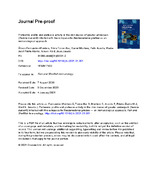Mostrar el registro sencillo del ítem
Proteomic profile and protease activity in the skin mucus of greater amberjack (Seriola dumerili) infected with the ectoparasite Neobenedenia girellae - An immunological approach
| dc.contributor.author | Fernández-Montero, Álvaro | |
| dc.contributor.author | Torrecillas, Silvia | |
| dc.contributor.author | Montero, Daniel | |
| dc.contributor.author | Acosta, Felix | |
| dc.contributor.author | Prieto-Álamo, M. José | |
| dc.contributor.author | Abril, Nieves | |
| dc.contributor.author | Jurado, Juan | |
| dc.date.accessioned | 2024-01-23T20:13:39Z | |
| dc.date.available | 2024-01-23T20:13:39Z | |
| dc.date.issued | 2021 | |
| dc.identifier.issn | 1050-4648 | |
| dc.identifier.uri | http://hdl.handle.net/10396/26700 | |
| dc.description.abstract | Skin mucus is considered the first barrier against diseases in fish. The skin mucus protein profile of the greater amberjack (Seriola dumerili) and its changes due to experimental infection with Neobenedenia girellae were studied by combining 2-DE-MS/MS and gel-free LC-MS/MS proteomic approaches. The 2-DE results led to the identification of 69 and 55 proteins in noninfected and infected fish, respectively, and revealed that keratins were specifically cleaved in parasitized fish. Therefore, the skin mucus of the infected fish showed a higher protease activity due to, at least in part, an increase of metal-dependent protease and serine-type protease activities. Additionally, through a gel-free LC-MS/MS analysis, 1377 and 1251 different proteins were identified in the skin mucus of healthy and parasitized fish, respectively. The functional analysis of these proteins demonstrated a statistical overrepresentation of ribosomal proteins (a well-known source of antimicrobial peptides) in N. girellae-infected fish. In contrast, the components of membranes and protein transport GO categories were underrepresented after infection. Immune system process-related proteins constituted 2.5% of the total skin mucosal proteins. Among these skin mucosal proteins, 14 and 15 proteins exclusive to non-parasitized and parasitized fish were found, respectively, including specific serine-type proteases and metalloproteases in the parasitized fish. Moreover, the finding of tryptic peptides exclusive to some bacterial genera, obtained by gel-free LC-MS/MS, allowed us to construct a preliminary map of the microbiota living in the mucus of S. dumerili, with Pseudomonas and Paracoccus the most represented genera in both noninfected and infected fish. | es_ES |
| dc.format.mimetype | application/pdf | es_ES |
| dc.language.iso | eng | es_ES |
| dc.publisher | Elsevier | es_ES |
| dc.rights | https://creativecommons.org/licenses/by-nc-nd/4.0/ | es_ES |
| dc.source | Fernández-Montero, Á., Torrecillas, S., Montero, D., Acosta, F., Prieto-Álamo, M. J., Abril, N., & Jurado, J. (2021). Proteomic profile and protease activity in the skin mucus of greater amberjack (Seriola dumerili) infected with the ectoparasite Neobenedenia girellae - An immunological approach. Fish & shellfish immunology, 110, 100–115.https://doi.org/10.1016/j.fsi.2021.01.001 | es_ES |
| dc.subject | Skin mucus | es_ES |
| dc.subject | Greater amberjack (Seriola dumerili) | es_ES |
| dc.subject | Proteome | es_ES |
| dc.subject | Neobenedenia girellae | es_ES |
| dc.subject | Protease | es_ES |
| dc.subject | Microbiota | es_ES |
| dc.title | Proteomic profile and protease activity in the skin mucus of greater amberjack (Seriola dumerili) infected with the ectoparasite Neobenedenia girellae - An immunological approach | es_ES |
| dc.type | info:eu-repo/semantics/article | es_ES |
| dc.relation.publisherversion | https://doi.org/10.1016/j.fsi.2021.01.001 | es_ES |
| dc.rights.accessRights | info:eu-repo/semantics/openAccess | es_ES |

